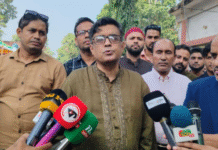A case for modifying tannery waste to produce poultry feed

We all know that solid tannery waste was used as the principal component of poultry/fish feed previously, but it has been recently banned by the Supreme Court because of its possible adverse health effects for the consumers. Tannery waste is one of the most obnoxious, foul-smelling and toxic industrial wastes. The traditional disposal method for solid tannery waste is land-filling. Whereas this has been the practice all over the world, in my opinion, Bangladesh is not a suitable country for landfills. Its soil is alluvial and is prone to be easily washed away by the torrential monsoon rains. As a consequence, toxic substances can find their way into nearby wetlands and streams, causing widespread pollution to the environment.
Besides, Bangladesh is a small country with a huge population and the land is scarce and expensive. But the country’s leather industry is expanding rapidly and comes next to the readymade garments (RMG) industry in foreign exchange earnings. It would be nice, therefore, to find an alternative method of disposal of tannery waste. From the scientific and technological point of view, the modern-day trend is to convert waste into wealth. Despite a lot of unfair publicity against tannery waste, it is basically a protein-rich substance and if we could somehow get rid of its toxic part, the protein part could be profitably utilised. In this article, I would like to propose a simple, implementable method of removal of the toxic component from solid tannery waste.
The toxicity of tannery waste is, primarily, due to the presence of chromium. Amongst the available tanning methods, chrome-tanning is the most popular where chromium sulfate is added as a tanning agent. Chromium exists in many states, and in the public perception, any type of chromium is a health hazard, which is not necessarily true. In the present context, we will limit our discussion to only two states of chromium: trivalent chromium and hexavalent chromium, the two most stable states of chromium.
Chromium sulfate is really trivalent chromium and some of it may be oxidised to hexavalent state during the different steps of the tanning process. As it turns out, hexavalent chromium is much more toxic than the trivalent one. For example, hexavalent chromium is carcinogenic but there is no evidence whatsoever of trivalent chromium causing cancer. Moreover, small amounts of trivalent chromium are good for health. It is essential for the maintenance of glucose, cholesterol and fatty acid metabolism at the normal level. A detailed comparison between trivalent and hexavalent chromium is beyond the scope of this short article. Suffice it to say that hexavalent chromium is some 500-1000 times more toxic than trivalent chromium. If we could somehow get rid of this hexavalent chromium from tannery waste—or from poultry feed, for that matter—it would be safe to consume chicken and, more importantly, this would pave the way for the utilisation of solid tannery waste.
Fortunately, it is quite easy to reduce hexavalent chromium to a trivalent one, which is the more stable of the two. Two conditions have to be satisfied: one, a reducing agent has to be added, and two, the medium should be made acidic. Inorganic reducing agents and inorganic acids should be avoided as they may themselves be toxic. Instead, we can use ascorbic acid, which is vitamin C, as the reducing agent, and a stronger acid like citric acid may be used to bring down the pH to the desired level. Lemons, which contain both ascorbic and citric acids, may be directly applied along with additional amounts of citric acid to create the proper reducing atmosphere.
Solid tannery waste contains both untanned components like raw trimmings and fleshings (66 percent) and tanned components like splits, shavings and crusts (34 percent). To be used for poultry feed, they are boiled together, dried and then ground. The resulting product, called protein concentrate, is then mixed with soya oil cake, ground rice, and dry fish to produce poultry feed. In the proposed method, the same procedure may be adopted except that boiling should be done in the presence of water, and that towards the end of the boiling step, required amounts of ascorbic and citric acids should be added. A very important part of the procedure is to separate the solid part through filtration or any convenient means from the liquid part. It is the solid part that has to be ground and used in poultry feed.
The poultry feed prepared in this way should be safe because it would contain no or a negligible amount of hexavalent chromium. The amount of trivalent chromium would also be much less than what it was initially, as most of it would go into solution, from which chromium can be recovered through standard methods.
The above proposal is based on laboratory studies but I am sure our experts in this area can make it work on a commercial scale. A detailed cost-benefit analysis can be deferred till the method is finally established. However, a little reflection suggests that the cost of the production of poultry feed would go up a bit but the benefits would far outweigh the costs. If enough poultry feed is manufactured domestically, there will be little or no need to import it from abroad. The need for landfills will drastically come down. Most importantly, with the Effluent Treatment Plant (ETP) taking care of the liquid tannery waste and the solid waste utilised this way, our environment will be spared from the horrible consequences of pollution from the tannery industries.
M Lutfor Rahman, PhD (Cantab), is a retired professor of chemistry, University of Rajshahi. Email: rahmanlutfor21@gmail.com









